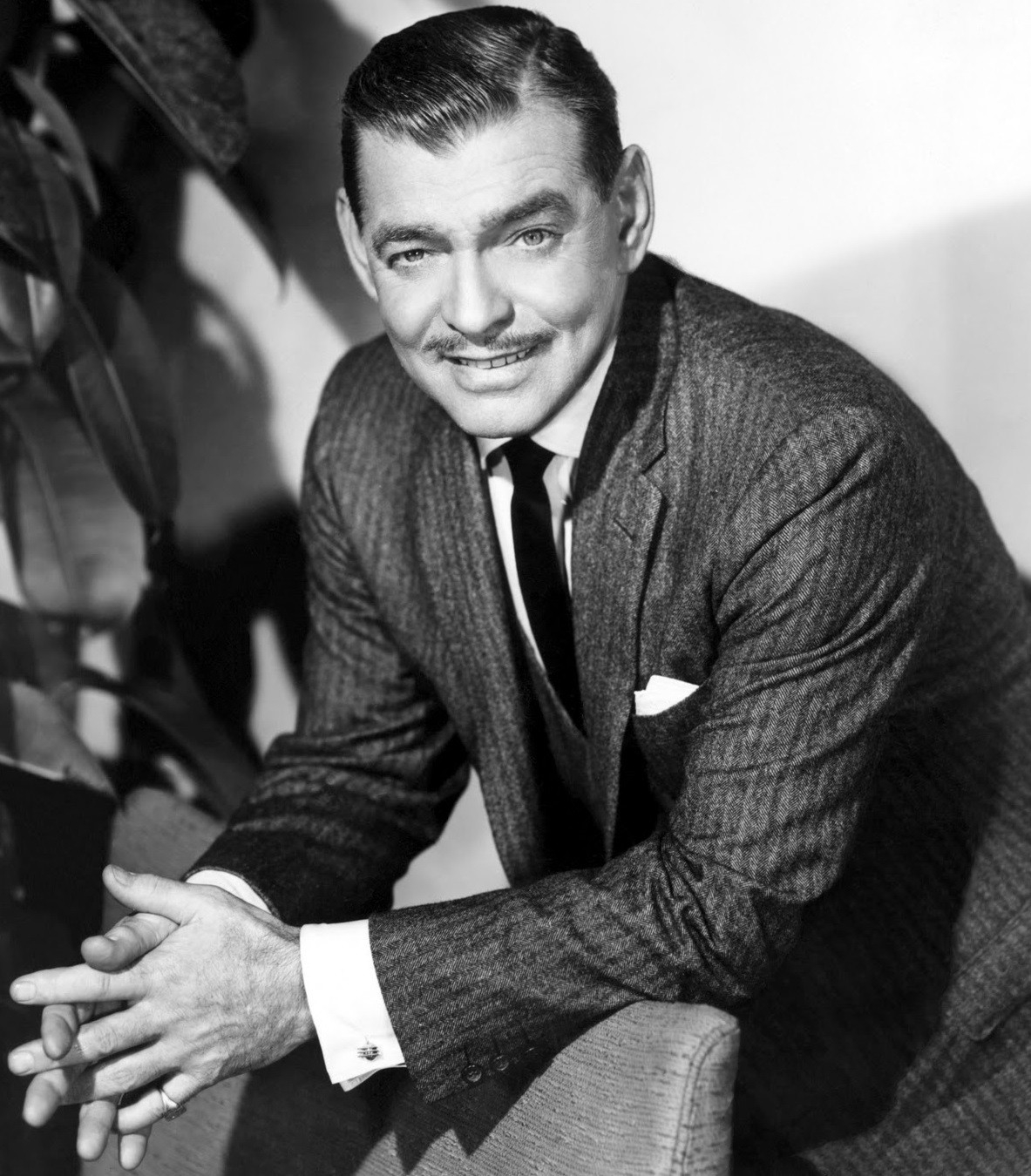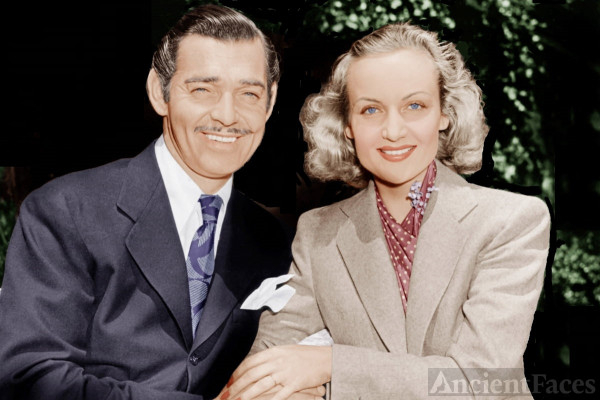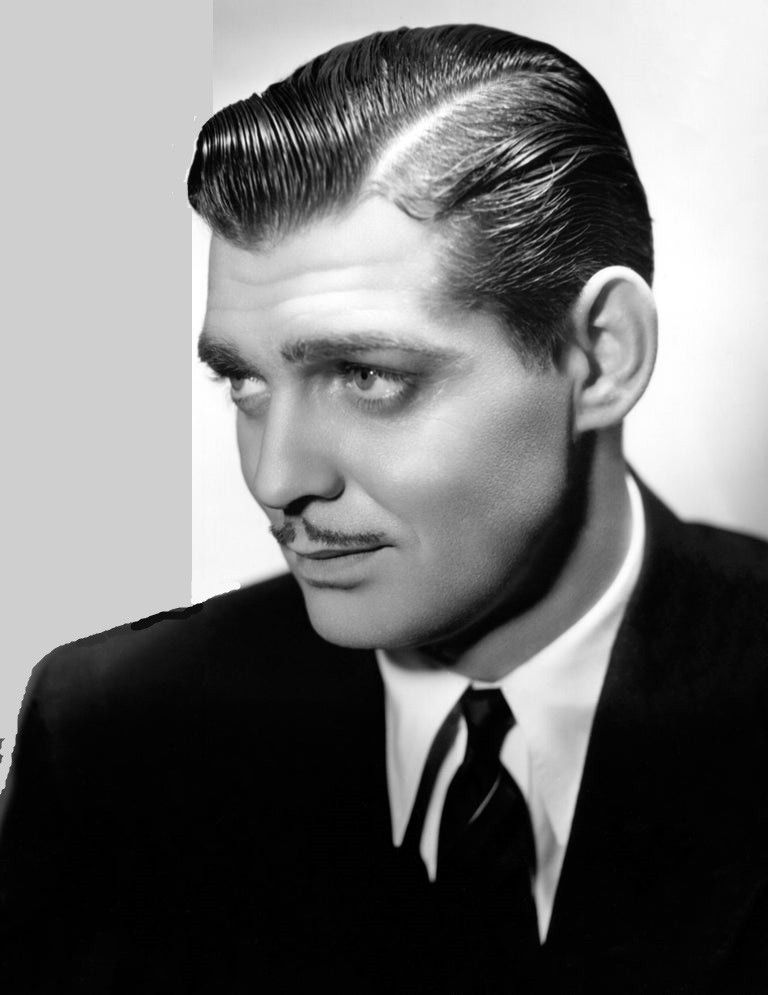Family (3)
Spouse Kay Williams (11 July 1955 - 16 November 1960) (his death) (1 child)
Sylvia Ashley (20 December 1949 - 21 April 1952) (divorced)
Carole Lombard (29 March 1939 - 16 January 1942) (her death)
Maria Franklin Gable (19 July 1931 - 4 March 1939) (divorced)
Josephine Dillon (13 December 1924 - 1 April 1930) (divorced)
Children John Clark Gable
Judy Lewis
Parents William Henry Gable
Adeline Gable
Trade Mark (4)
Tapered mustache that hugged his upper lip
Often played a virile, lovable rogue whose gruff facade only thinly masked a natural charm and goodness.
Distinctive, powerful voice
Oversized ears
Trivia (111)
Adolf Hitler esteemed the film star above all other actors, and during the war offered a sizable reward to anyone who could capture and return Gable, who had enlisted in the Army Air Corps and was flying combat missions over Germany, unscathed to him.
A few months after his death, Gable's widow, Kay (1917-1983), gave birth to John Clark Gable, a race-car driver and sometime actor.
In the 1970s his Encino, CA, estate was subdivided and turned into a very upscale tract development called "Clark Gable Estates".
Interred at Forest Lawn, Glendale, CA, in the Great Mausoleum, Sanctuary of Trust, on the left hand side, next to Carole Lombard.
In 1995 was chosen by "Empire" magazine as one of the 100 Sexiest Stars in film history (#36).
It was at his 36th birthday that Judy Garland sang "Dear Mr. Gable: You Made Me Love You".
His first two wives--Josephine Dillon and Maria Franklin Gable (aka Ria Langham)--were 14 and 17 years older than he was, respectively.
When he was first cast in It Happened One Night (1934) opposite Claudette Colbert, he told director Frank Capra that he would give the role a shot, but if things weren't going well after a few days, he would leave the production.
So durable that he could play the same role in both an original (Red Dust (1932)) with Jean Harlow and Mary Astor, and its remake (Mogambo (1953)) with Ava Gardner and Grace Kelly.
When he was born he was mistakenly listed as a female on his birth certificate.
He disliked Greta Garbo, a feeling that was mutual. She thought his acting was wooden while he considered her a snob.
Playing a cowboy in his last film, The Misfits (1961), which was also the final film for co-star Marilyn Monroe. The aging Gable diligently performed his own stunts, taking its toll on his already failing health. He died from a heart attack before the film was released.
Pictured on one of four 25¢ US commemorative postage stamps issued on 23 March 1990 honoring classic films released in 1939. The stamp features Gable and Vivien Leigh as Rhett Butler and Scarlett O'Hara from Gone with the Wind (1939). The other films honored were Beau Geste (1939), Stagecoach (1939) and The Wizard of Oz (1939).
Grandfather of Clark Gable III, who is the first child of his son, John Clark Gable, and his ex-wife Tracy Yarro. Clark James Gable was born on September 10, 1988 at a hefty 10 lb.
He was dyslexic, a fact that didn't emerge until several years after his death.
Cousin-in-law of William B. Hawks.
On July 12, 1942, Gable enlisted in Army Air Corps during World War II in honor of his late wife Carole Lombard, who was killed earlier that year (along with her own mother) in a plane crash while on tour selling war bonds. He was commissioned an officer with service number 565390. Rose to the rank of captain and served primarily in Public Affairs, making training films and performing public relations visits to soldiers and airmen in Europe. He also trained as an aerial gunner and he flew five combat missions with the 8th Air Force's 351st Bombardment Group (Heavy) while making his films and was awarded the Distinguished Flying Cross and Air Medal. He was discharged (separated) from the Air Force on June 12, 1944. Captain Ronald Reagan of the First Motion Picture Unit of the Army Air Corps signed Gable's separation papers.
Inducted into the Lou Holtz/Upper Ohio Valley Hall of Fame in 2004.
Was seriously considered to play Tarzan in Tarzan the Ape Man (1932), but was deemed an unknown and Johnny Weissmuller was chosen instead.
Was voted the 8th Greatest Movie Star of all time by "Entertainment Weekly".
Was Jerry Siegel and Joe Shuster's inspiration for half of Superman's alter ego name Clark Kent ("Kent" came from Kent Taylor).
He worked as a lumberman in the Willamette Valley of Oregon in the early 1920s. After a couple of months of doing that he quit, saying that "the work was too hard" and he would rather act instead. He then left to go to Hollywood, where he began his acting career.
In 1952, his widow, Kay Williams, divorced her previous husband, Adolph Spreckels Jr., heir to the Spreckels Sugar Co. fortune. In the divorce papers she alleged that he beat her with one of her slippers.
Gable's fourth wife, Lady Sylvia Ashley, was born Edith Louise Sylvia Hawkes in 1904. She was the widow of Douglas Fairbanks. Her first husband was Lord Anthony Ashley (they divorced November 28, 1934), her third was Lord Stanley of Alderney, and her fifth was Prince Dimitri Djordjadze (whom she married in 1954 and stayed married to until her death). She died June 29, 1977. Her grave stone refers to her as "Princess Sylvia Djordjadze".
He was voted the 21st Greatest Movie Star of all time by "Premiere Magazine".
Named the #7 greatest actor on The 50 Greatest Screen Legends List by the American Film Institute
In some radio interviews at the end of his life, his voice has a haunting similarity to Walt Disney's.
Is the subject of the song "Clark Gable" by The Postal Service.
Is portrayed by James Brolin in Gable and Lombard (1976), Bruce Hughes and Shayne Greenman in Blonde (2001), Charles Unwin in Lucy (2003), Larry Pennell in Marilyn: The Untold Story (1980), Edward Winter in The Scarlett O'Hara War (1980), Boyd Holister in Grace Kelly (1983) and Gary Wayne in Malice in Wonderland (1985).
Military records on celebrities released by the Pentagon in 2005 reveal that Gable, upon enlistment, was described as a "motion picture specialist" and his weekly wage was listed as $7,500. A movie cameraman, Andrew J. McIntyre, enlisted along with Gable and trained with him, the documents showed. "In order to have something definite to describe and some tangible evidence of his experiences, it is proposed that there be enlisted his cameraman to be trained as an aerial gunner also who may make pictures of Gable in various theaters of operations," one Army memo said.
Prior to making The Misfits (1961), he crash-dieted from a bloated 230 lb. to 195 lb. Twice in the previous decade he had suffered seizures that might have been heart attacks; once, ten years earlier, while driving along a freeway he had chest pains so severe that he had to pull off the road and lie down on the ground until he felt well enough to continue on.
His father was of German, some Swiss-German, and distant Irish, ancestry. His mother was of half German and half Irish descent.
Gave his Oscar for It Happened One Night (1934) to a child who admired it, telling him it was the winning of the statue that had mattered, not owning it. The child returned the Oscar to the Gable family after Clark's death.
His first screen test was made by director Mervyn LeRoy for Warner Bros. When studio head Jack L. Warner and production chief Darryl F. Zanuck saw the test they were furious at LeRoy for wasting their money on that big "ape" with those "huge floppy taxi-cab ears". Years later when Gable made it big, LeRoy used to tease Warner and say, "How would you like to have him and those huge floppy ears now?".
Served as a pallbearer and usher at Jean Harlow's funeral in 1937.
In 1938, a poll of entertainment readers, he was overwhelmingly selected "King of Hollywood" and was officially crowned by columnist Ed Sullivan.
At the time of his death his gun collection was valued at $500,000. He had a special gun room in his house filled with gold-inlaid revolvers, shotguns and rifles.
On November 6, 1960, Gable was devastated to learn of the unexpected death of his close friend Ward Bond from a heart attack. Shortly afterward, he also suffered a massive heart attack (while reading a magazine). President Dwight D. Eisenhower, a close friend, sent him a message of support wishing him a speedy recovery. Gable died in the hospital ten days after his infarction. Although it is often claimed that he died as a result of Marilyn Monroe's behavior and performing his own stunts in The Misfits (1961), he was already in terrible health when filming began from years of excessive drinking and smoking more than three packs of cigarettes a day. He was interred at Forest Lawn, (Glendale, California) in the Great Mausoleum, Sanctuary of Trust, on the left hand side, next to Carole Lombard.
Second cousin of film producer Thomas R. Bond II, President of American Mutoscope & Biograph, a motion picture and entertainment company.
In 1939, part of his and Carole Lombard's honeymoon was spent at the Willows Inn in Palm Springs, CA. Today the Inn continues to operate and anyone can stay in the same room, which is largely unaltered since then.
Sources say he turned down the role of Col. William Travis in The Alamo (1960) because he didn't want to be directed by John Wayne. However, this seems unlikely since Travis was 26 at the time of the battle and Gable would have been 58 when the movie was filmed.
Although he was never crowned #1 at the box office in the Top 10 Poll of Money-Making Stars, as ranked by Quigley Publications' annual survey of movie exhibitors, he made the list a then-record 15 times from 1932-49, and a 16th time in 1955. Gable, "The King", was ranked in the top four of box-office stars every year from 1934-39 (the "Golden Age" of Hollywood), ranking #2 in 1934 and 1936-38, inclusive, when he was topped by Shirley Temple. After ranking #3 at the box office Office in 1940, he slumped to #10 in 1941, a position he also held in 1942 and 1943. After returning from the war, he took the #7 spot in the box-office poll in 1947 and 1948, before again slumping to #10 in 1949. He made his last appearance in the Top 10 in 1955, when he again placed #10.
Despite his dyslexia, he became an avid reader. He would never allow himself to be photographed reading on film sets, fearing it would undermine his macho screen image.
Discouraged by his failure to progress in films, he tried the stage and became an employable actor, first in stock and eventually on Broadway, without acquiring real fame. When he returned to Hollywood in 1930 for another try at movie acting, his rugged good looks, powerful voice and charisma made him an overnight sensation as the villainous Rance Brett in his first sound picture, The Painted Desert (1931). He exploded onto the screen in a dozen 1931 releases, in small parts at first, but he was an established star by the end of the year.
Reportedly attempted suicide on a high-powered motorbike following the tragic and untimely death of his wife Carole Lombard.
During his time on Broadway, Gable worked as a stage gigolo, performing stud services for such actresses as Pauline Frederick and Laura Hope Crews, who were considerably older than he. (Crews would later play "Aunt Pittypat" in Gone with the Wind (1939).) His much older first wife served as his first acting coach and paid for his false teeth. Later he married a woman 17 years his senior, Texan heiress Maria Franklin Gable, who had underwritten his successful assault on Hollywood.
He became increasingly unhappy with the mediocre roles offered him by MGM as a mature actor. He refused to renew his contract with them in 1953 and proceeded to work independently.
He was a conservative Republican, although his third wife Carole Lombard, a liberal Democrat, encouraged him to support President Franklin D. Roosevelt's New Deal reforms. In February 1952 Gable addressed a televised rally at Madison Square Gardens in New York in support of Republican candidate Dwight D. Eisenhower, and a few days before his death he voted by post for Richard Nixon in the 1960 presidential election.
On June 11, 1933, he was hospitalized for pyorrhea, an infection of the gums the day before he was to begin shooting Dancing Lady (1933). He was hospitalized for several days, after which most of his teeth were extracted. The infection would have killed him had he not been rushed to a private hospital for treatment. Afterwards, he went on a vacation to Alaska and Canada with his wife, as it would take a couple of weeks for his gums to heal enough so he could be fitted for dentures. MGM shot around him until he returned and was fitted with a dental plate, but on July 30, after one day's shooting, the infection felled him again. In the days before antibiotics, the infection was so serious that his gall bladder was removed. Out for another month, the film had to be shut down and went $150,000 over budget. MGM boss Louis B. Mayer docked him two weeks pay, which caused bad feelings between the studio and its top star, although his illness was genuine and he was not malingering. To teach him a lesson, Mayer lent him to Columbia Pictures, then a "Poverty Row" studio, to make a comedy. The movie, Frank Capra's masterpiece It Happened One Night (1934), swept the Academy Awards the next year and brought Gable his only Oscar.
On 3/15/46 he was injured in a car crash at the traffic circle at Sunset Blvd. and Bristol Ave. in the Los Angeles neighborhood of Brentwood. According to a press release from MGM, he was driving east on Sunset Blvd. and had entered the south half of the traffic circle when he was struck by another car, whose driver apparently had become confused by the "roundabout" and was driving in a westerly direction on the same arc of the circle. Gable drove his car over a curb to avoid hitting the the other car, and it struck a tree, throwing him against the steering wheel. He was treated at Cedars of Lebanon Hospital for a bruised chest and a cut on his right leg that required stitches. The driver of the other car drove away from the site without checking on Gable or reporting the accident. The hit-and-run accident gave rise to the urban legend that Gable had struck and killed a pedestrian while driving drunk, an incident that allegedly was covered up by MGM. Though reported in several biographies, there is no basis in fact for the allegations.
An early member of the right-wing Motion Picture Alliance for the Preservation of American Ideals, in the 1950s Gable joined Walt Disney, John Wayne, James Stewart and other politically conservative entertainers to "assist" the House Un-American Activities Committee (HUAC) in its efforts to find alleged Communist infiltration in the film industry.
Wanted his headstone to read "Back to silents", but his widow didn't use it.
As head of the actors' division of the Hollywood Victory Committee, he sent his wife Carole Lombard on one of the first tours, in January 1942, to her home state of Indiana, where she sold $2 million worth of bonds. On the plane trip back to Hollywood the plane crashed, killing Lombard and her mother. Gable drank heavily for six months before enlisting as a private in the Army Air Corps. He served as a combat cameraman in Britain, rose to the rank of major and eventually was furloughed to work at Hal Roach Studios--"Fort Roach", as the First Motion Picture Unit headquarters came to be known. His discharge papers were signed by Capt. Ronald Reagan.
In 1999, the American Film Institute named him among the Greatest Male Stars of All Time, ranking at #7.
Turned down Cary Grant's role in The Philadelphia Story (1940) because he thought the film was too wordy.
Baptized as a Catholic, but raised as a Protestant, Gable did not practice any religion as an adult. His private funeral service, at the Church of the Recessional in Forest Lawn Park, was attended by some 200 mourners, including Spencer Tracy, Robert Taylor, James Stewart, Norma Shearer, Ann Sothern, Marion Davies, Frank Capra, Robert Stack, Jack Oakie, Roy Rogers, Dale Evans, Van Johnson and Howard Strickling, Gable's longtime publicity man at MGM. There was no eulogy. The closed casket was adorned with yellow roses shaped like a crown, befitting the one-time King of Hollywood.
On November 5, 1960, Gable suffered his first heart attack when he was changing a tire on his jeep. President Dwight D. Eisenhower, a close friend of his, sent him a message of support wishing him a speedy recovery.
Contrary to popular belief, he did not perform his own stunts in The Misfits (1961). He was only used for the close-ups, while a stunt double stood in for him in the long shots. His heart attack was caused by his lifestyle--30 years of heavy smoking and drinking, plus his increasing weight in later years. It is also believed his crash diet before filming began may have been a contributing factor.
Director Howard Hawks had long intended to make Hatari! (1962) with Gable and John Wayne. However, by the time filming began Gable was already dead.
In the mid-1950s he started to receive television offers but rejected them outright, even though some of his peers, like his old flame Loretta Young, were flourishing in the new medium.
In 1955 he formed a production company with Jane Russell and her husband Robert Waterfield, and they produced The King and Four Queens (1956), the star's one and only production. The stress of making the film took such a toll on his health that he decided not to produce again.
Well known for his pipe smoking, sustaining at least two bowlfuls a day. To this day he still has pipes named after him.
Originally the image of him as an outdoorsman was an invention of the studios, designed to bolster his masculine screen image during the early 1930s. However, he soon discovered that he enjoyed hunting, shooting and fishing, so the image swiftly became the reality.
In order to expedite the divorce from his second wife Ria so he could marry Carole Lombard, he paid her a $500,000 settlement in 1939, nearly everything he had at the time.
Despite his rising popularity, he balked at playing gangsters and overtly callous characters, and was therefore very pleased to be cast in Red Dust (1932), the film that set the seal on his stardom.
As a teenager his voice was very high-pitched; however, with vocal training he was able to lower it over time. His voice later proved a major asset in his climb to fame.
Once named Mutiny on the Bounty (1935) as the favorite of his movies, despite the fact that he did not like co-star Charles Laughton. He was also initially disappointed by the casting of Franchot Tone as Midshipman Byam, since the two actors had been bitter rivals for the affections of Joan Crawford. However, during filming they became close friends.
He disliked his most famous film Gone with the Wind (1939), which he regarded as "a woman's picture.".
He liked westerns, and once expressed his regret that he didn't make more of them.
He and then future wife Carole Lombard first met in late 1924 while working as extras on the set of Ben-Hur: A Tale of the Christ (1925). They would make three films together as extras--Ben-Hur (1925), The Johnstown Flood (1926) and The Plastic Age (1925)--and star together in No Man of Her Own (1932), but not become romantically involved until 1936.
Met his second wife while appearing in a play. Booth Franklin brought his sister, Maria ("Ria"), backstage and introduced them. Gable's two stepchildren by this marriage were Jana and Alfred. In 1935, Gable flew to Houston, Texas to give Jana away at her marriage to Dr. Thomas Burke. Clark and Ria separated later that same year, in October 1935.
Gable and Loretta Young had a romance during the filming of Call of the Wild (1935). Young became pregnant. To hide that she and Gable had produced an out-of-wedlock child, fearing it would ruin both of their careers due to strict morality clauses, Loretta Young secretly gave birth to Judy Lewis, while ostensibly vacationing in Europe. When she returned to Hollywood, she claimed Judy was adopted. Gable met Judy only once when she was a teenager.
His father always opposed his decision to become an actor, and even after became a major star he still denounced acting as a "sissy" occupation. Gable became a Freemason in 1933 just to please his father. However, he showed no grief when his father died at age 78 from a heart attack on 4 August 1948, having outlived his three wives.
Died on the first birthday of his granddaughter, Maria.
In 1949 he served as a pallbearer at the funeral of director Victor Fleming, whom he considered something of a father figure.
Turned down Robert Mitchum's role in Home from the Hill (1960).
He was so disappointed by the critical and commercial failure of Adventure (1945) that he did not agree to make another film until more than a year had passed. Fortunately, The Hucksters (1947) proved to be a success and his performance was acclaimed.
Although discharged from the US Army Air Force early in 1944, he refused to make another movie until the war had ended.
Watched very little television except boxing matches.
Had a fear of flying, and made all long journeys across America by train.
Grandfather of Kayley Gable.
He was already good friends with Hattie McDaniel prior to their making Gone with the Wind (1939) together, and wanted her to play the part of "Mammy", but it was her coming fully dressed and nailing the part that got her the coveted role. When it came time for the premiere on December 15, 1939, producer David O. Selznick attempted to bring along McDaniel. MGM advised him not to because of Georgia's strict segregation laws, which would have prevented McDaniel from being at the same function, on an equal basis, with whites. Gable was so outraged he told MGM he would not attend the premiere unless she was allowed to attend, also. She eventually convinced him to attend without her.
In the late 1940s MGM wanted to cast him alongside Angela Lansbury in a drama to be called "Angel's Flight" but he strongly disliked the story line and the studio canceled the picture.
Has appeared in five films that were nominated for the Best Picture Oscar: It Happened One Night (1934), Mutiny on the Bounty (1935), San Francisco (1936), Test Pilot (1938) and Gone with the Wind (1939), and if confirmed his appearance in The Front Page (1931) the number goes to six films. Of those, It Happened One Night (1934), Mutiny on the Bounty (1935) and Gone with the Wind (1939) are winners in the category.
He appeared in three Best Picture Oscar winners, the first two of which were in consecutive years: It Happened One Night (1934), Mutiny on the Bounty (1935) and Gone with the Wind (1939). Every time he was nominated for a Best Actor Oscar, the film he was in won Best Picture. He won Best Actor for It Happened One Night. Wallis Clark also appeared in all three films.
Was a chain smoker by the time he was 16. He was known to smoke three or four packs of cigarettes a day as an adult.
Declined an offer to make a film with Errol Flynn, reportedly because Flynn was eight years his junior.
Was the second husband of Carole Lombard, while his Manhattan Melodrama (1934) co-star William Powell was her first.
Played the part of a newspaper reporter in nine films, more than any other kind of role.
Recovering alcoholic Spencer Tracy tried to avoid him when he was trying to quit drinking, as Gable was always surrounded by alcohol.
He never wanted to do either of the two films that gave him his biggest recognition--It Happened One Night (1934) (on loan to Columbia by MGM as punishment), which earned him an Oscar, and Gone with the Wind (1939), which he never really liked even after it was completed. That film earned him another Oscar nomination but not the support of MGM, which was touting Robert Donat in Goodbye, Mr. Chips (1939) to give the film much needed box-office strength.
Only child of William (1870-1948) and Adeline (née Hershelman) Gable (1869-1901); both were born in Pennsylvania.
Paternal grandson of Charles (1830-98) and Nancy (née Steinbrook) Gable (1837-1927). Both were born and raised in Pennsylvania.
Paternal great-grandson of Jacob (1792-1885) and Rebecca (née McFadden) Steinbrook (1806-1877). Both were born and raised in Pennsylvania.
Wore lifts to play Rhett Butler in Gone with the Wind (1939).
He co-starred in eight movies with Joan Crawford: Dance, Fools, Dance (1931), Laughing Sinners (1931), Possessed (1931), Dancing Lady (1933), Chained (1934), Forsaking All Others (1934), Love on the Run (1936) and Strange Cargo (1940). They also both appeared, uncredited, as extras in The Merry Widow (1925) and Ben-Hur: A Tale of the Christ (1925).
Irving Thalberg suggested him for the lead role in Scarface (1932), but Howard Hawks turned him down, saying, "We need a real actor, not some personality.".
He was considered for the role of Bick Benedict in Giant (1956), but was deemed too old for the part.
On February 8, 1960, he received a star on the Hollywood Walk of Fame for his work in motion pictures, located at 1608 Vine St.
Referenced in Have You Got Any Castles? (1938).
Maternal grandson of John (1833-1921), born in New York, and Rosetta (née Clark) Herschelman (1847-86), born in Pennsylvania.
Maternal great-grandson of Timothy (1805-83) and Jane (née Bullock) Clark (1810-80). Both were born in Antrim, Northern Ireland, and emigrated to Pennsylvania.
Maternal great-grandson of Philip (1799-1888) and Anna (née Werner) Herschelman (1792-1892). Both were born in Germany and emigrated to Pennsylvania.
Referenced in The Three Stooges: Movie Maniacs (1936).
On August 18, 2018, he was honored with a day of his film work during the TCM Summer Under The Stars.
He was considered for Gregory Peck's roles in Twelve O'Clock High (1949) and The Gunfighter (1950).
He has appeared in four films that have been selected for the National Film Registry by the Library of Congress as being "culturally, historically or aesthetically" significant: Ben-Hur: A Tale of the Christ (1925), Red Dust (1932), It Happened One Night (1934) and Gone with the Wind (1939).
Director John Huston had originally planned to make a film of 'The Man Who Would be King' with Clark Gable and Humphrey Bogart in the lead roles but Bogies death put a stop to it.
Before entering film world he drifted through numerous jobs including salesman, lumberjack, reporter, and truck driver.
After completing Somewhere I'll Find You (1942) he enlisted as a private in the US Army Air Corps.
Caricatured in Hollywood Steps Out (1941).
Personal Quotes (43)
The only reason they come to see me is that I know that life is great - and they know I know it.
[on his acting ability] I worked like a son of a b**** to learn a few tricks and I fight like a steer to avoid getting stuck with parts I can't play.
This "King" stuff is pure bullshit. I eat and sleep and go to the bathroom just like everybody else. There's no special light that shines inside me and makes me a star. I'm just a lucky slob from Ohio. I happened to be in the right place at the right time, and I had a lot of smart guys helping me--that's all.
Working with Marilyn Monroe on The Misfits (1961) nearly gave me a heart attack. I have never been happier when a film ended.
[about The Misfits (1961)] This is the best picture I have made, and it's the only time I've been able to act.
Hell, if I'd jumped on all the dames I'm supposed to have jumped on, I'd have had no time to go fishing.
The things a man has to have are hope and confidence in himself against odds, and sometimes he needs somebody, his pal or his mother or his wife or God, to give him that confidence. He's got to have some inner standards worth fighting for or there won't be any way to bring him into conflict. And he must be ready to choose death before dishonor without making too much song and dance about it. That's all there is to it.
It is an extra dividend when you like the girl you've fallen in love with.
I hate a liar. Maybe because I'm such a good one myself, heh? Anyway, to find someone has told an out-and-out lie puts him on the other side of the fence from me for all time.
I'm no actor and I never have been. What people see on the screen is me.
[on rumors he was dull in bed] I can't emote worth a damn.
Everything Marilyn [Marilyn Monroe] does is different from any other woman, strange and exciting, from the way she talks to the way she uses that magnificent torso.
[on Spencer Tracy] The guy's good. There's nobody in the business who can touch him, and you're a fool to try. And the b****** knows it, so don't fall for that humble stuff!
Every picture I make, every experience of my private life, every lesson I learn are the keys to my future. And I have faith in it.
I am intrigued by glamorous women . . . A vain woman is continually taking out a compact to repair her makeup. A glamorous woman knows she doesn't need to.
[about Gary Cooper] Coop is a right guy, the kind you like to hunt and fish with and not talk about making movies. I laid it on him one time about his romance with Carole [Carole Lombard, Gable's wife] and he got pale as hell. She told me about it during a drunken argument we had. After that, Coop and I didn't hunt together so much and when we did, we kept an eye on each other. She used to throw him up to me in my face and that was hard to take, especially since I didn't know the whole truth until years later. I got to admit I was jealous.
[on playing Rhett Butler in Gone with the Wind (1939)] I discovered that Rhett was even harder to play than I had anticipated. With so much of Scarlett preceding his entrance, Rhett's scenes were all climaxes. There was a chance to build up to Scarlett, but Rhett represented drama and action every time he appeared. He didn't figure in any of the battle scenes, being a guy who hated war, amid he wasn't in the toughest of the siege of Atlanta shots. What I was fighting for was to hold my own in the first half of the picture--which is all Vivien's [Vivien Leigh]--because I felt that after the scene with the baby, Bonnie, Rhett could control the end of the film. That scene where Bonnie dies, and the scene where I strike Scarlett and she accidentally tumbles down stairs, thus losing her unborn child, were the two that worried me most.
Types really don't matter. I have been accused of preferring blondes. But I have known some mighty attractive redheads, brunettes, and yes, women with grey hair. Age, height, weight haven't anything to do with glamour.
[on Jean Harlow] She didn't want to be famous. She wanted to be happy.
I bring to a role everything I am, was and hope to be.
This power that I'm supposed to have over women was never noticed when I was a stage actor on Broadway. I don't know when I got it. And by God, I can't explain it.
I don't believe I'm king of anything, but I know why they like to think I am. I'm not much of an actor, but I'm not bad unless it's one of those things outside my comprehension. I work hard. I'm no Adonis, and I'm as American as the telephone poles I used to climb to make a living. So men don't get sore if their women folks like me on the screen. I'm one of them, they know it, so it's a compliment to them. They see me broke, in trouble, scared of things that go bump in the night, but I come out fighting. They see me making love to Jean Harlow or Claudette Colbert and they say, 'If he can do it, I can do it,' and figure it'll be fun to go home and to make love to their wives.
[in 1958] My days of playing the dashing lover are over. I'm no longer believable in those parts. There has been considerable talk about older guys wooing and winning leading ladies half their age. I don't think the public likes it, and I don't care for it myself. It's not realistic. Actresses that I started out with like Joan Crawford and Barbara Stanwyck have long since quit playing glamor girls and sweet young things. Now it's time I acted my age. Let's be honest. It's a character role, and I'll be playing more of them. There's a risk involved, of course. I have no idea if I can attain the success as a character actor as I did playing the dashing young lover, but it's a chance I have to take. Not everybody is able to do it.
I don't want a lot of strangers looking down at my wrinkles and my big fat belly when I'm dead.
When I die, don't let them make a circus out of it.
Method actors are like hams.
If any child of mine becomes an actor I will turn in my grave.
The public interest in my playing Rhett [in Gone with the Wind (1939)] puzzled me. I was the only one, apparently, who didn't take it for granted that I would. I found myself trapped by a series of circumstances over which I had no control. It was a funny feeling. I think I know now how a fly must react after being caught in a spider's web. Scarlett doesn't always love Rhett. It's the first time that the girl isn't sure that she wants me from the minute she sets eyes on me.
Single men never have any problems. I suppose that the public builds some kind of idea from what they've seen of me on the screen.
I don't discuss women at all with anyone. There are good qualities in all women. Some may be lacking in some of these qualities and should have them. I'm liable to say so and hurt their feelings, and it wouldn't be meant that way at all.
I was scared, when I discovered that I had been cast by the public. I felt that every reader would have a different idea as to how Rhett should be played on the screen, and I didn't see how I could please everybody.
["Miami News" article 1939 on public reaction to Gone with the Wind (1939)] Damn it. I never conceived of this. When I rode through Atlanta's streets today it wasn't like an opening at Grauman's Chinese at Hollywood. It wasn't like anything I ever experienced in my life. It was almost too big for me to take. For the first time I actually realized I wasn't Clark Gable to Atlanta, but Rhett Butler [laughs] . . . and I hope to heaven when I leave here tomorrow night, after everybody has seen the picture, that I leave as Rhett Butler and not Clark Gable.
[In 1932] I have been in show business for 12 years. They have known me in Hollywood but two. Yet as picture-making goes, two years is a long time. Nevertheless, my advice has never been asked about a part in a picture. I found out I was going into "Susan Lenox" in Del Monte. Read it in a paper. When I walked on the set one day, they told me I was going to play Red Dust (1932) in place of John Gilbert. I have never been consulted as to what part I would like to play. I am paid not to think.
I was pretty sore because they insisted on taping my ears back. One day, in a scene with [Greta Garbo], the tape snapped loose and one ear flapped in the breeze. That was the end of the taping.
They see me as an ordinary guy, like a construction worker or the guy who delivers your piano.
It's a chain of accidents. When you step into Hollywood, you wind yourself into thousands of chains of accidents. If all of the thousands happen to come out exactly right--and the chance of that figures out to be one in eight million--then you'll be a star.
[on playing Fletcher Christian in Mutiny on the Bounty (1935)] The character is a pansy. And I'm not going to be seen wearing a pigtail and knickers.
[on Carole Lombard] After we got married, I asked her what she wanted more than anything. We were looking over the property and she said, "I'd like manure for the bottom thirty." And she meant it, too.
[on The Misfits (1961)] The title sums up this mess. [Arthur Miller, [Marilyn Monroe] and [Montgomery Clift]--they don't know what the hell they're doing. We don't belong in the same room together.
[What he wants on his tombstone] "He was lucky and he knew it".
[on his preference for brothels] When it's over it's over. No questions, no tears, no farewell kisses.
[in 1955] When I came to town 25 years ago my 6'2" were considered pretty high up. But year by year they keep coming in--taller and taller. Today, it would appear than an actor under six feet is virtually a runt.
[on his appeal to moviegoers] The reason they come to see me is because I know life is great. And they know I know it. They see me get a kick out of all living. They know that even if I had known what was going to happen to Carole [Carole Lombard], for instance, it was worth it.
Salary (20)
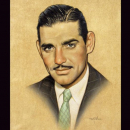
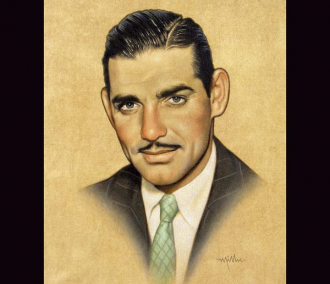
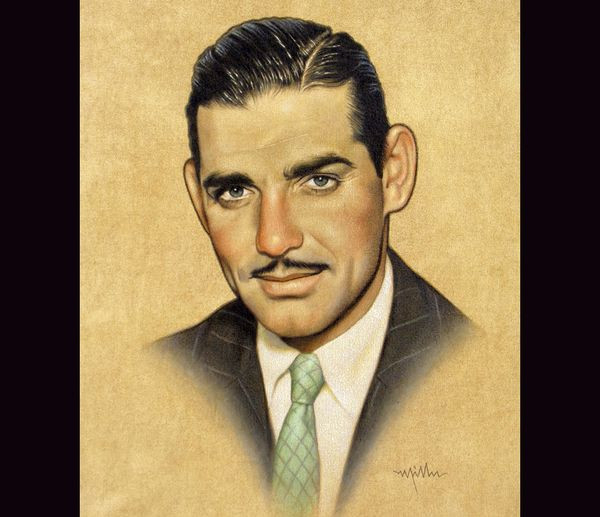
 Amanda S. Stevenson
Amanda S. Stevenson 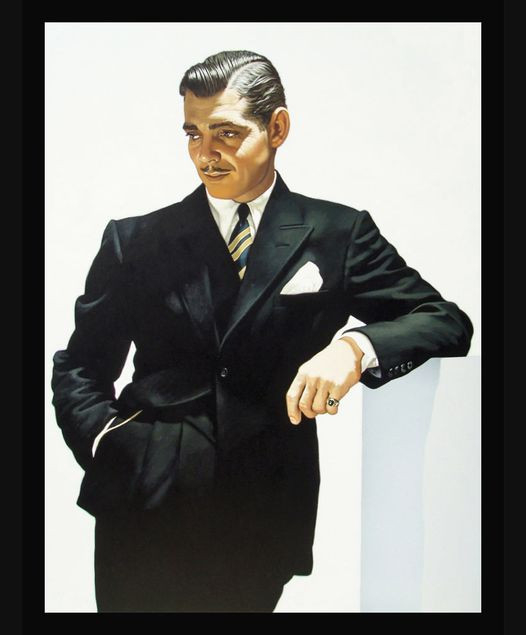
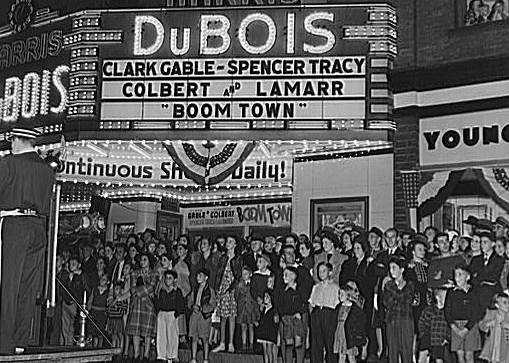
 AncientFaces
AncientFaces 